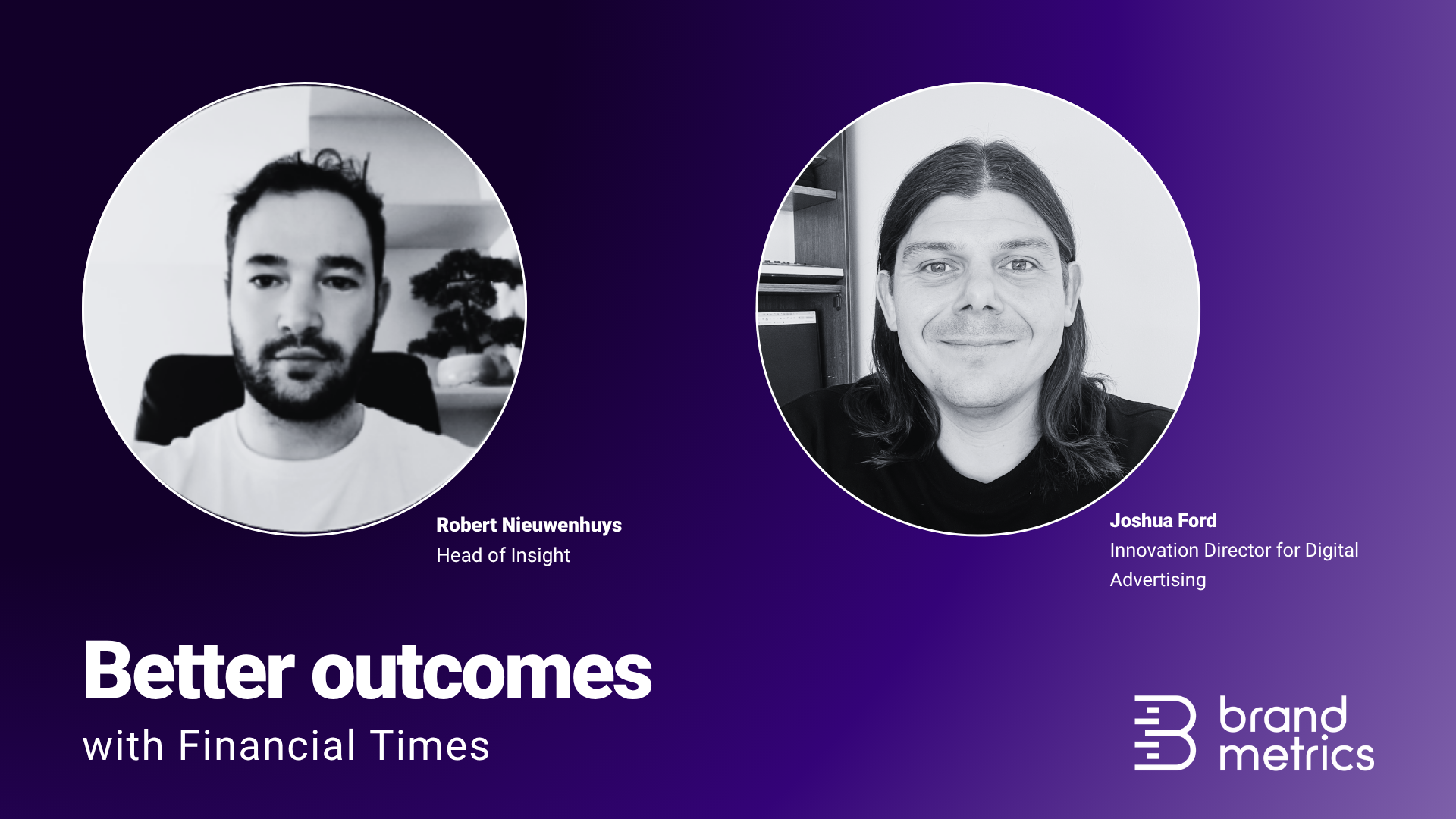Better Outcomes: DPG Media
In this third edition of our Better Outcomes series, we hear from Simon Harris, Director of Ads Strategy at DPG Media.
Simon brings over 15 years of experience in ad operations, paid social, and programmatic trading. Having led trading operations across multiple holding companies, he joined DPG Media in 2020, one of Europe’s largest publishing businesses. His focus: proving the value of quality media to DPG Media’s customers in a fast-evolving digital ecosystem.
1. Introducing Outcomes Data
For Simon, outcomes data is fundamentally how customers measure the success of their advertising with DPG Media.
“Outcomes Data is a broad church. There are lots of different types: engagement metrics, user behaviour, conversion metrics, customer satisfaction data, advertising metrics, brand perception metrics that may all contribute to success,” says Simon Harris.
The metrics that matter depend on campaign goals.
For brand-building video activity, the key outcomes might be shifts in awareness and consideration.
For performance-led campaigns, measuring conversions through DPG’s Conversion Measurement API or Enhanced Conversions service is more relevant.
DPG Media collects a wide range of campaign metrics – reach, viewability, and attention – but Simon notes that advertisers increasingly expect more than delivery data.
“As we enter the outcomes era, our customers quite rightly want more than this.”
The company regularly measures changes in awareness, consideration, preference, and action intent across its sites and apps, and has extended its partnership with Brand Metrics to broaden these capabilities into Connected TV.
For advertisers seeking immediate conversion data, DPG Media offers first-party measurement tools free of charge. Clients can even compare conversion uplift between users exposed to ads and those eligible but unexposed, all in a privacy-safe environment using DataLab or external clean rooms.
2. How Outcomes Measurement Has Evolved
Digital advertisers have been assessing campaign impact for over two decades, but as digital has become dominant, the demand for verified outcomes has intensified.
“As digital has become the dominant channel in many advertisers’ mix, demand for outcomes measurement has increased.”
Simon points to Apple’s privacy changes (ITP in 2017 and ATT in 2022) as key inflection points that made it harder for advertisers to see full performance across ecosystems. DPG Media’s response has been to bridge the gap between media metrics and business outcomes, helping advertisers measure what truly matters.
3. Industry Demand
The industry is shifting. As buyers pay closer attention to supply chain transparency, publishers are playing a more active role in proving value.
“It’s perhaps more important for the industry that the supply chain gets increasingly transparent and efficient.”
DPG Media has already taken steps in this direction—rationalising the number of exchanges it works with and enabling buyers to bid directly into its ad server through its Ad Manager platform.
The type of outcomes data in demand depends on the advertiser.
- Direct response advertisers have long relied on conversion tracking, but this is harder to measure online, opening the door to measuring mid-funnel metrics.
- Brand-focused advertisers increasingly measure lift in awareness, consideration, preference, and intent.
- Some now also explore footfall and in-store purchase measurement as omnichannel solutions mature.
“As technology has improved, the range of outcomes that advertisers can measure has also increased—and so has the appetite.”
Research from the IAB Europe supports this, showing that almost half (46%) of buyers now use outcomes to measure campaign success, although many still rely on quality metrics like viewability.
4. Collecting Outcomes Data
DPG Media offers a comprehensive suite of measurement tools:
- Brand Metrics – to measure uplift in mid-funnel metrics: awareness, consideration, preference, and intent.
- Conversions API – for deterministic, cookieless conversion measurement.
- Enhanced Conversions – to match sales and ad delivery data safely in clean rooms.
- Drive to Store – to measure whether campaigns drove in-person visits.
“The main challenge today versus 5 years ago is that while imperfect, using third-party cookies to measure effectiveness was actually relatively easy.”
Simon acknowledges that newer privacy-first methods are less polished than legacy tools, but believes that transitioning to more sustainable measurement is both essential and inevitable.
5. Using Outcomes Data
DPG Media uses outcomes data to demonstrate the value of quality media – whether broadcast content or news media – particularly as advertisers are now faced with a vast array of lower-cost alternatives.
“Proving the value of quality media has never been more important.”
A clear example is DPG Media’s collaboration with Brand Metrics to develop new methods for measuring Connected TV effectiveness – a move that helps validate the role of premium video content versus social media video.
Because customers measure campaign success via a broad range of metrics, DPG Media has built out measurement capabilities that do not just cover one area but give clients the optionality to measure a wide range of success metrics.
Internally, outcomes data informs both commercial strategy and product development. Simon describes it as “a prime input for improving our products,” helping DPG Media evolve its ad offering in line with advertiser needs.
6. Looking Ahead
The future of outcomes measurement is heading towards predictive and AI-driven models.
“One can easily see that data from campaigns will one day be used to understand which audiences respond well and automate targeting based on this.”
Simon also highlights an emerging challenge: while privacy legislation is often discussed, platform-specific attribution models pose an even greater issue for advertisers trying to interpret performance consistently.
“Major platforms all have proprietary measurement and attribution models, which makes understanding what’s driving results very difficult.”
As advertisers turn to incrementality and contribution-based measurement, DPG Media’s mission remains clear: to help clients connect the dots between high-quality media and measurable business impact.
Closing Thoughts
At DPG Media, outcomes data isn’t just about metrics, it’s about proving the unique value of premium environments. By investing in transparent tools, privacy-safe attribution, and partnerships like Brand Metrics, Simon and his team are helping redefine what success looks like in digital advertising.



.png)


.png)
.png)
 TL (1920x1080).jpg)


